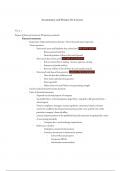Summary
Summary Accountancy and Finance for Lawyers Course Notes
- Course
- Institution
Notes for the Accountancy and Finance for Lawyers course (3rd year Global Law, Business Minor), includes lecture and reading notes (embedded in class notes). Includes all equations and their context and explanation.
[Show more]



